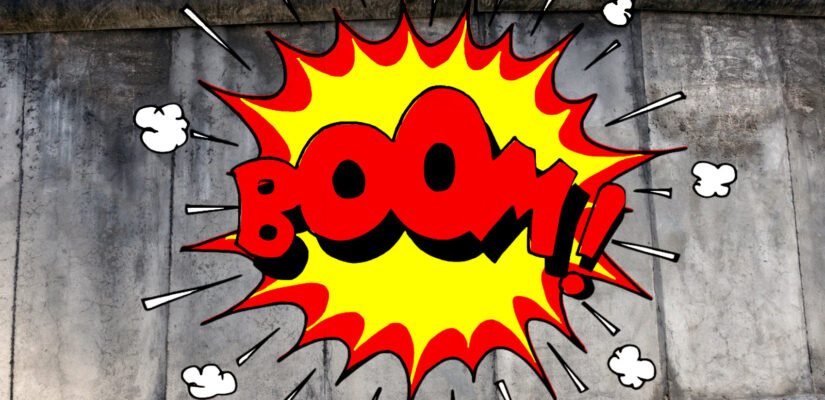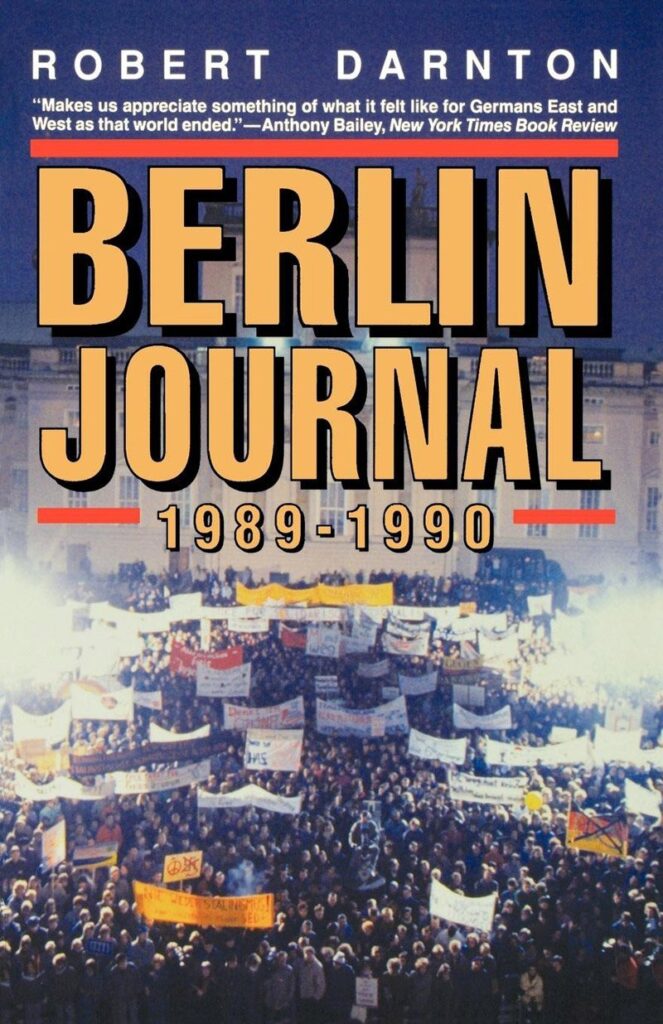
The Fall of the Berlin Wall | (dot)history

(dot)history | A space by MANUEL D’ELIA
For 28 years it divided a country, a continent, the East from the West; in few hours it became a forceful metaphore of the mutability of things. Not many episodes in human history can symbolize a revolution likewise the fall of the Berlin wall. The report of those days is entrusted to Robert Darnton, American historian, among the major scholars of the eighteenth century.

«On the morning after, November 10, when both Berlins woke up wondering whether the first flood through the Wall had been a dream, the West Berlin tabloid Volksblatt ran two headlines, shoulder to shoulder, on it’s front page: “The Wall is gone” and “Bonn Demands the Destruction of the Wall”.
Both were right. The Wall is there and it is not there. On November 9, it cut through the heart of Berlin, a jagged wound in the middle of a great city, the Great Divide of the Cold War. On November 10, it had become a dance floor, a picture gallery, a bulletin board, a movie screen, a videocassette, a museum, and, as the woman who cleaned my office put it, “nothing but a heap of stones”. The taking of the Wall, like the taking of the Bastille, transformed the world. No wonder that a day later, in Alexanderplatz, East Berlin, one conqueror of the Wall marched in a demonstration with a sign saying simply, “1789-1989”. He had helped dismantle the central symbol around which the postwar world had taken shape in the minds of millions.
To witness symbolic transformation on such a scale is a rare opportunity and it raises many questions. To begin with the most concrete: What happened between November 9 and November 12, and what does it mean?
The destruction of the Wall began in the early evening of Thursday, November 9, soon after the first wave of East Berliners, or Ossis, as they are called by the West Berliners here, burst upon the West. One Ossi, a young man with a knapsack on his back, somehow hoisted himself up on the Wall directly across from the Brandeburg gate. He sauntered along the top of it, swinging his arms casually at his sides, a perfect target for the bullets that had felled many other wall jumpers, like Peter Fechter, an eighteen-year-old construction worker, who was shot and left to bleed to death a few feet in front of Checkpoint Charlie on August, 1962. Now, twenty-seven years later, a new generation of border guards took aim at a new kind of target and fired-but only with power hoses and without much conviction. The conqueror of the Wall continued his promenade, soaked to the skin, until at last the guards gave up. Then he opened his knapsack and poured the water toward the East, in a gesture that seemed to say, “Good-bye to all that”.
A few minutes later, hundreds of people, Ossis and Wessis alike, were on the Wall, embracing, dancing, ex-changing flowers, drinking wine, helping up new “conquerors” – and chipping away at the Wall itself. By midnight, under a fool moon and the glare of spotlights from the watchtowers in no man’s land, a thousand figures swarmed over the Wall, hammering, chiseling, wearing its surface away like a colony of army ants. At the bottom, “conquerors” threw stones at its base or went at it pickaxes. Long slits appeared, and the light showed through from the East, as if through the eyes of a jack-o’lantern. On the top, at the center of the tumult, with the Brandeburg Gate looming in the background, one Ossi conducted the destruction with a sickle in one hand a hammer in the other.
By Saturday, November 11, chunks of the Wall were circulating through both Berlins. People exchanged them as souvenirs of what had already taken shape in the collective consciousness as a historical event: the end of the Cold War. A sidewalk entrepreneur sold bits of wall from a table on the Ku’damm: 20 DM for a piece of the past. At one point, an East Berliner walked by and objected, with a smile on his face: “you can’t sell that. It’s our Wall. It belong to us”.
Like any powerful symbol, the Wall has acquired many meanings, and they differ significantly from West to East. The Wall even looks different if you study it from one side and then the other. Seen from the West, it is a prison wall that encloses the East Berliners in totalitarianism. Tourists climb on observation towers and shudder deliciously at the spectacle: the monstrous, graffiti-covered concrete structure, the no man’s land beyond it – which until 1985 was mined and rigged with rifles that fired automatically at anyone who dashed across – the barbed wire, the dog patrols, the turrets with armed guards staring back through binoculars, and the secondo wall or windowless buildings on the far side of the deadly, desolate, space.
East Berliners see a different wall. Theirs is painted in patterns of light and dark blue, clean, bright, and fee of all graffiti. It shuts off the view of the repressive apparatus beyond it. If you lose your way or stray into outlying areas in East Berlin, you can drive along the wall for miles without noticing that it is something more than an ordinary part of the urban landscape. […]
To someone unfamiliar with Berlin, it may be hard to imagine how successfully the Wall had divided the city. Soon after 1961, when the Wall went up, the million or so inhabitants on the Western side and the 2 million or so on the Eastern began to lose contact. By 1989, a whole generation had come of age within the shadow of the Wall. Most of them never crossed it, even from West to East when that was allowed. They accepted the Wall as a fact of life, as something inexorable, built into the landscape – there when they were born and there when they died. They left it to the tourists, took it for granted, forgot about it, or simply stopped seeing it. Many West Berliners did not see the Wall until it ceased to exist. For the Wall enclosed the West Berliners even more thoroughly than it shut off their counterparts in the East. In 1961 it was perceived as a noose that would soon choke the life out of the western half of the city. But by 1989, West Berliners had come to regard the Wall as a source of support. Thanks to its presence, the government in Bonn poured billions into Berlin, subsidizing everything from the philharmonic orchestra to teen-age jazz groups. A whole population of underemployed intellectuals grew up around the Free university, which now has about 60.000 students. As residents of Berlin, they are exempt from the draft; they also can drink beer and talk politics in pubs throughout the night, for Berlin is the only city in the Federal Republic where the pubs are permitted to stay open past midnight, the only place where you can order breakfast in the afternoon. Many of these free-floating intellectuals became freeloaders. They lived off the Wall; and if it really falls, they may face a greater economic disaster than the Berliners in the East.
To Berliners, therefore, the Wall means something very different from what it means outside the city. But most of them realize that their local barrier is bound up with larger divisions, the Oder-Neisse line in particular and the general dividing line between the Warsaw Pact and NATO.
Having gone to bed one day in a world with clearly defined boundaries, they woke up the next in a world without firm national borders, without balanced power blocs, and even without obvious demarcations of time, because it suddenly seemed possible to produce a treaty ending World War II forty-four years after Work War II had ended. They are living a truism of anthropology: the collapse of boundaries can be deeply disturbing, a source of renewal but also a threat to a whole worldview.
The mood remains euphoric, nonetheless. In East Berlin especially, the idea has spread that in conquering the Wall the people seized power. No one denies that power comes out of the barrel of a gun, but it has symbolic forms, too. The demonstrations in the streets sapped the legitimacy of the regime. Combined with the hemorrhaging of the population across the borders, they brought the government down, without a shot fired. […]
We may never know the details of what happened inside the crumbling power structure of the GDR. But whatever produced the occasion, the force that broke through the Wall was there for all to see on the night of November 9. It was the people of East Berlin. They took the Wall as they had taken to the streets for the previous two months, with nothing but their convictions, their discipline, and the power of their numbers.
When they came streaming into West Berlin, they spoke the language of liberty, but they expressed themselves by gesture, not by high-flown rhetoric. They took possession of the Wall physically, by pouring through it, climbing on it, and chipping it apart. They did the dame thing in West Berlin itself. They occupied space, swarming through the Ku’damm, filling the busses and pubs, parking their tiny Trabis on the nobles sidewalks, and returning triumphantly to the East with a flower for a girl friend ora toy for an infant.
It was a magical moment, the possession of a city by its people. On Thursday, November 9, under a fool moon, between the shadow of the Reichstag and the menacing bulk of the Brandenburg Gate, the people of Berlin danced on their Wall, transforming the cruelest urban landscape into a scene of hilarity and hope, and ending a century of war».
[R. Darnton, Berlin journal 1989-1990, W.W. Norton & Company, 1993, pp. 74-77; 83-86]